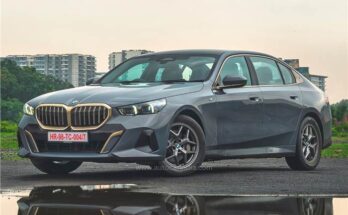Citroen’s little hatch goes all electric with the same hatch-SUV cross-appeal. But how does it perform?
Haute cross fun is how we described the C3 when we reviewed it, but does that hold true for the electric version? One look at the eC3 and it is clear that haute and cross are checked – the eC3 is near-identical to its petrol counterpart, so its hatch-SUV cross-appeal is intact. As is its upmarket and chic style, which takes cues from the premium C5 Aircross.
Citroen eC3: exterior design
Identical styling means the eC3 has the same upright stance as its ICE counterpart with all its sharp and smart details like the Chevron logo that flows neatly across the front splitting into the DRLs. Even the grille is the same open unit – not sealed, EV-like – and the bonnet has those nice deep creases. Our test car was the bright orange one with the optional white contrast accents and I especially like the ones on the side cladding.
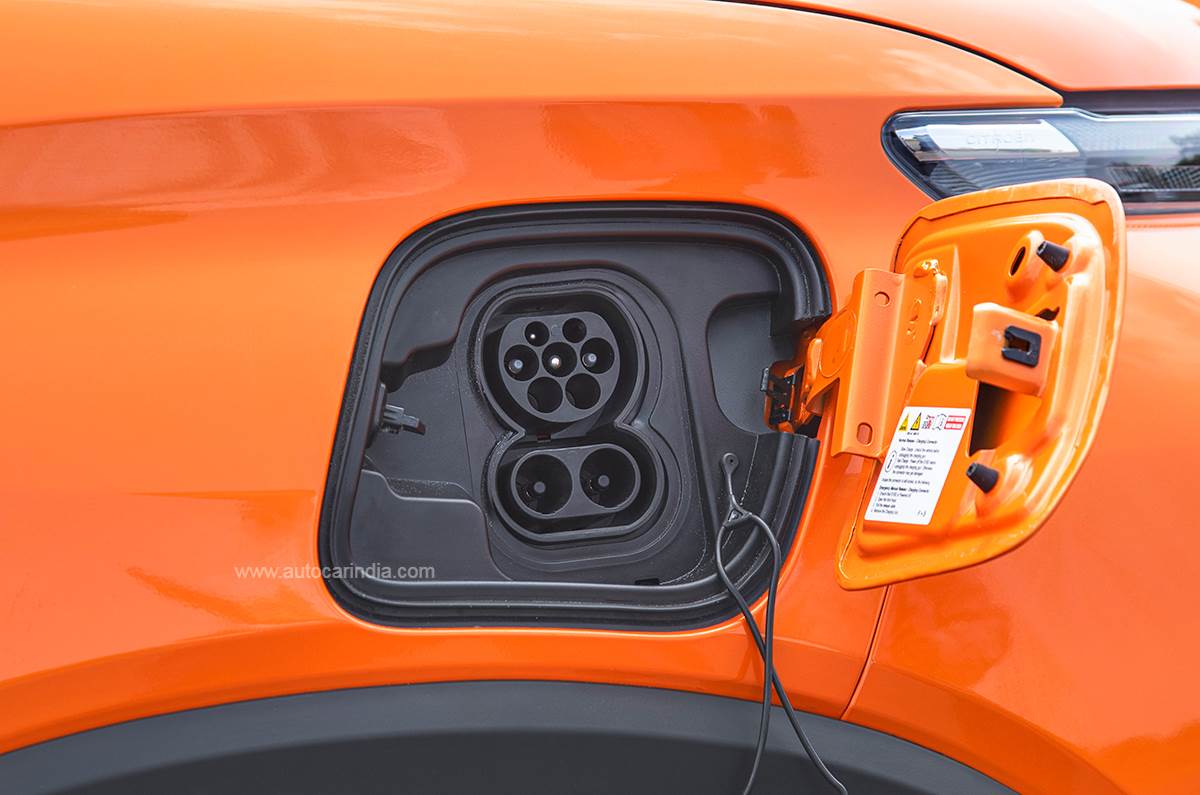 Cut out for charging port on front fender.
Cut out for charging port on front fender.
You have to look closely to spot differences between the ICE and EV variant, with the latter only sporting ‘e’ and eC3 badging, and a charging port flap cut into the right front fender. There’s even a blank fuel filler flap on the eC3, but it doesn’t open here. Look closely, however, and you’ll notice that between the wheels, the car sits lower thanks to the battery pack mounted below.
Ground clearance is reduced from 180mm to 170mm, but that’s still plenty. The floor has also risen by 70mm and at the rear you do sit in a knees-up position, but thankfully you can stretch out your legs quite a bit with ample room as well as space under the front seats.
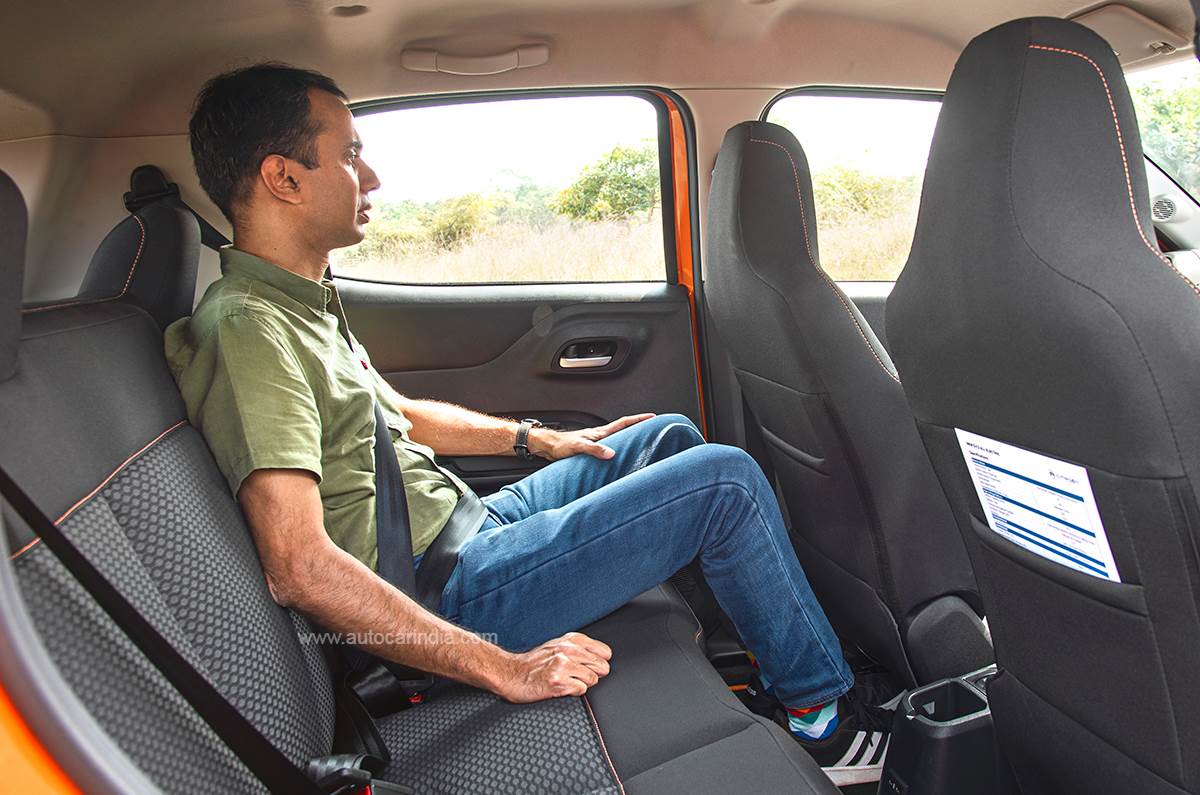 Floor is raised to accomodate battery, so you sit in a knees-up position.
Floor is raised to accomodate battery, so you sit in a knees-up position.
What’s interesting is that with a large 2,540mm wheelbase – larger than a Brezza, for example – the battery pack is a single unit contained entirely within the car’s wheelbase and not split like in the Tiago EV. The Tata has an additional unit housed behind the rear axle where the spare tyre would sit, thus the eC3 retains a spare wheel. Boot space stays the same as the ICE version at 315 litres.
Citroen says the C3’s CMP platform was always designed with electrification in mind and thus the eC3 comes to the market quickly – just six months after the ICE version. The company says it was able to package the battery neatly too. There isn’t a frunk (front bonnet), however, as the motor and controller unit take up that space.
Citroen eC3: interior
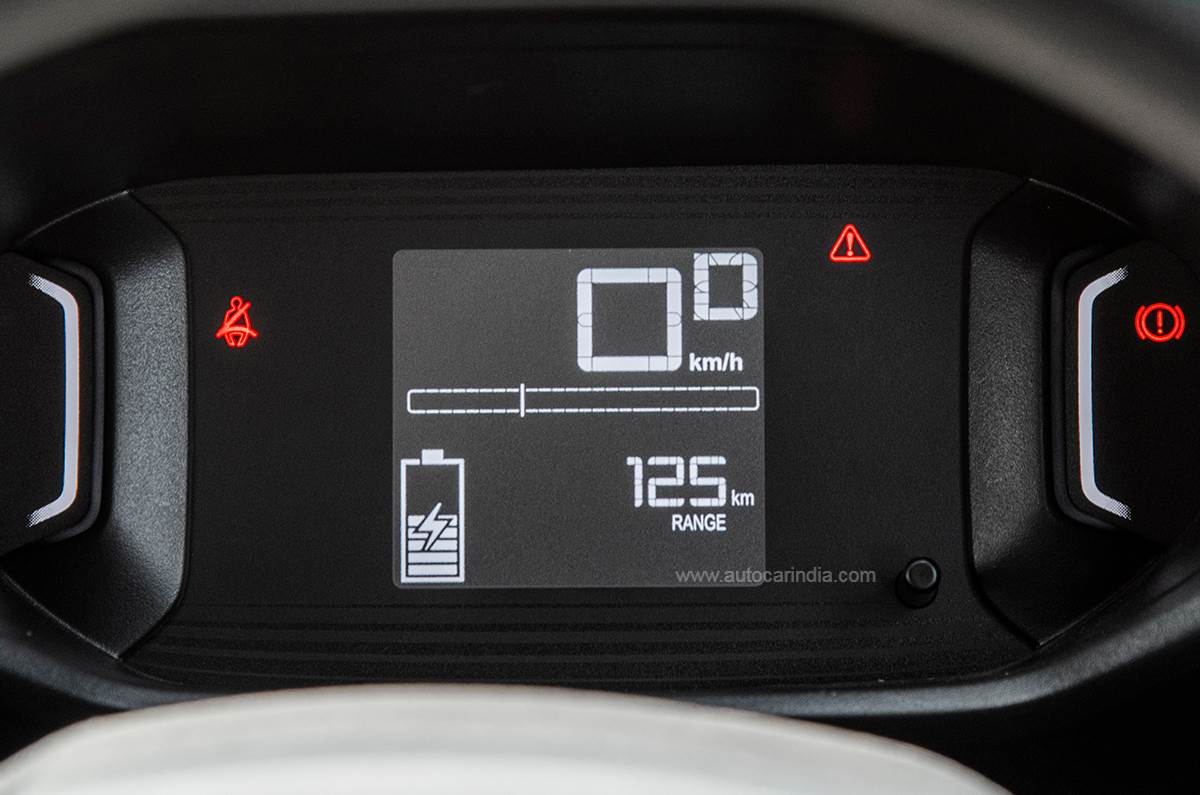 Digital instrument cluster is very basic; shows expected range and charge level.
Digital instrument cluster is very basic; shows expected range and charge level.
Inside too, the electric and ICE versions are the same with the only difference being the absence of a gear lever. In its place, you have a small toggle switch to select drive direction and a button below to select Eco mode. There’s handy storage around the cabin and the dash has the same neat contrast-styled panel that can be had in grey or bright orange. The steering wheel is the same unit with funky cubic-styled elements, while the small black and white instrument panel has a few added displays for range and charging.
The 10.2-inch screen is large and clear with neat-sounding speakers and wireless Android Auto and Apple CarPlay connectivity. Seats are also carried over, which means they are comfortable, both front and back. Space is also good for four adults with enough head- and legroom; five adults, though, will find the cabin narrow.
 Gear level has been replaced with a toggle switch.
Gear level has been replaced with a toggle switch.
Also identical is the equipment level, but this is not a good thing. Yes, there’s the big touchscreen and mercifully, unlike the petrol version, the eC3 now has a day/night adjustment for the IRVM, but a lot of basics are still missing. There’s no rear wash wipe or defogger, has a manual AC, manual ORVM adjustment and shared rear power window switches. On the ICE version, this looks sparse, but on the electric C3 – which will sit at a higher price – this lack of equipment will only appear starker. Making amends of sorts is a connectivity suite, which has functions like geo-fencing and intruder alert, and yes, this will make its way to the petrol car.
Citroen eC3: battery, range and motor power
Unlike other EVs at the budget end, the eC3 comes in one battery size only, which is a 29.2kWh lithium-ion pack. Range is a claimed 320km (ARAI), but as with all EVs, expect something much lower. We’ll hopefully put this through our test very soon where we will check range, performance and charging. Citroen does not supply a wall box charger, so at home on a 15A plug point, it will take 10.5 hours to go from 10 to 100 percent. To speed things up, you can charge it on a DC fast charger, but even here, speeds are controlled to a dawdling 7.2kW and will take about an hour to go from 10 to 80 percent.
 No frunk; space is taken up by motor and controller unit.
No frunk; space is taken up by motor and controller unit.
Thanks to the overall lower charging speed, Citroen says you can DC fast charge the car every time. To prolong battery life, others recommend using regular AC charging most often. The slower charging speed is on account of the battery’s cooling system. Unlike others that use liquid cooling, the eC3 has an air-cooled unit, and while this may sound alarming, it isn’t necessarily so. Batteries heat up only when charging and discharging rapidly and in the eC3 both are kept at a low rate. Even on a DC fast charger, charging speed is throttled back, while discharge demands are also low thanks to a motor that develops a modest 57hp – torque is a more respectable 143Nm – and draws power in a very measured fashion. The top speed is also limited to 107kph.
Citroen eC3: performance
All we got was a very short drive at the Wabco test track, but it’s instantly clear that performance isn’t the electric C3’s aim. Step on the throttle and power delivery is very sedate and acceleration is far from the typical instant response you get in an EV; after about 30kph, you do move a bit quicker though. Citroen claims a 0 to 60kph time of 6.8 seconds and top speed is limited to 107kph, which puts it behind the Tiago EV as far as the numbers go and it feels so too.
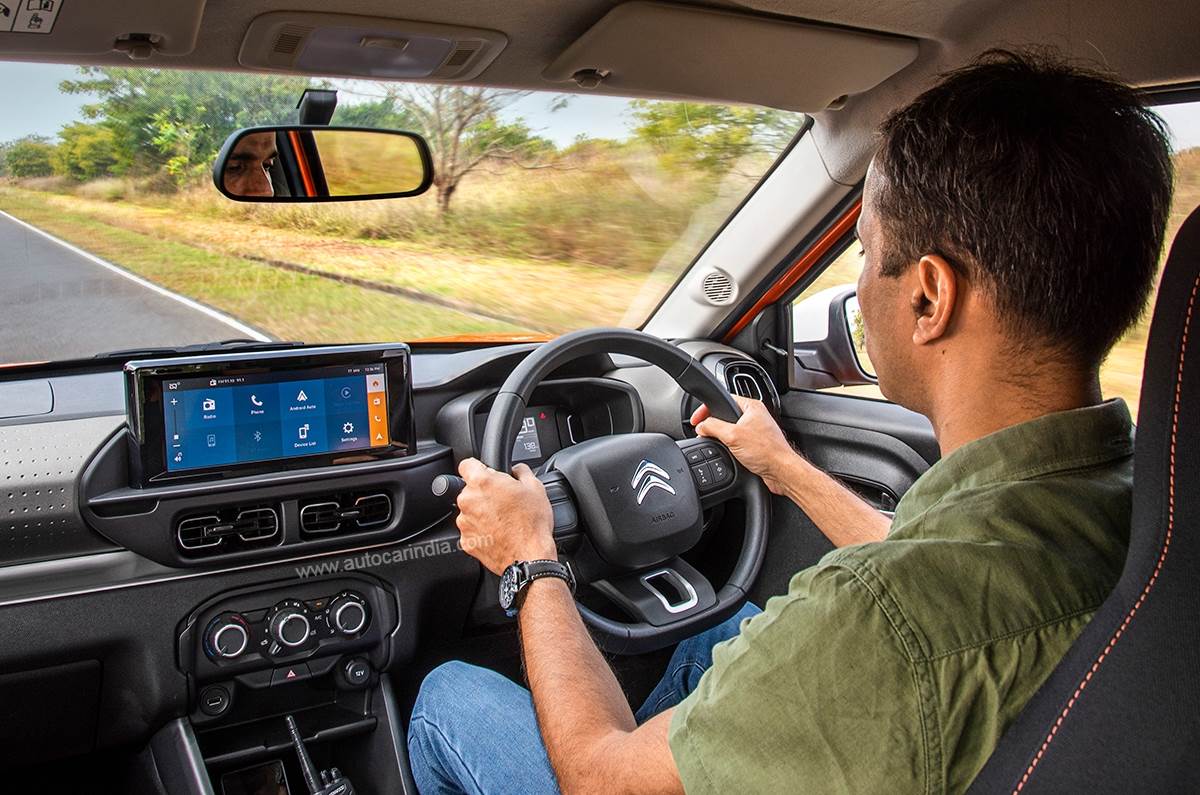 Whether its in Eco or Normal mode, the eC3 offers similar levels of performance.
Whether its in Eco or Normal mode, the eC3 offers similar levels of performance.
Thankfully, moving to Eco mode does not hamstring the performance and there’s little difference between the two modes. The electric Citroen C3 also has brake energy recuperation, which is at a fixed level with a retardation feel akin to engine braking on a regular ICE vehicle.
It’s a pity we didn’t get to drive eC3 in real-world conditions. In all likelihood, driving in thick traffic would have a better impression of the car’s performance. Besides the slow off-the-line response, it would perform just fine as a small city hatch. The electric Citroen is very silent with little to no motor whine intruding and is naturally smooth with an even power flow thanks to the absence of a regular gearbox.
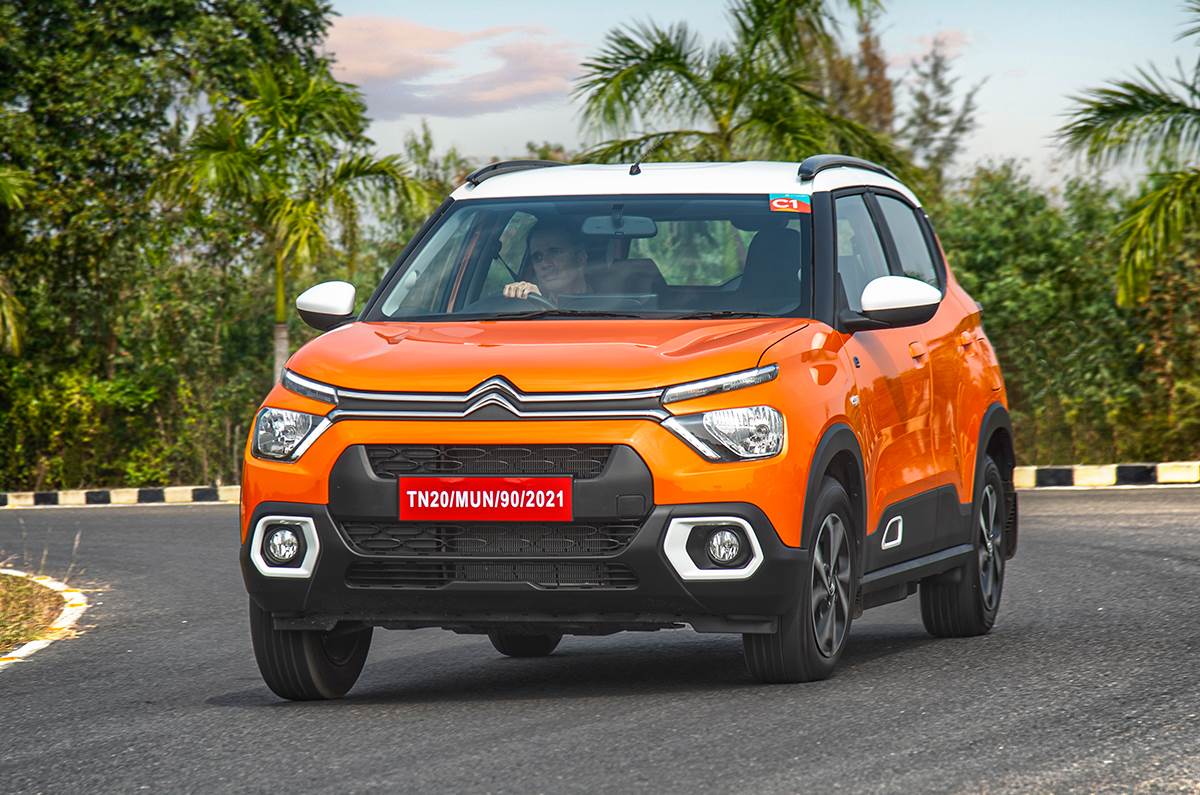 There is body roll and it’s clear that rather than handling, the eC3 is set up for ride comfort – a brand hallmark.
There is body roll and it’s clear that rather than handling, the eC3 is set up for ride comfort – a brand hallmark.
The steering isn’t one-finger-twirl light, but it’s just right and the weight imparts a degree of confidence around the few corners that we did encounter. Body roll is present, however, and it’s clear that the eC3 does not like to be hustled. The suspension is clearly geared towards ride comfort, which is a Citroen hallmark. Again, out in the real world, we will be able to judge ride quality, but expect the regular petrol version’s good bump absorption and a pliant ride.
Citroen eC3: price and verdict
It’s hard to come to a conclusion with a few minutes on a test track and not knowing the price. So treat this as a dipstick result with a few things quite clear; performance is disappointingly dull and the car is under-equipped and lacks the wow factor EV buyers would expect. On the plus side, it’s comfortable and looks sharp and chic. So it really comes down to price. Too far away from the Tiago EV will hamper its potential, priced close to it and there’ll be a good fight.

While Citroen will scoff at the idea of the Tiago EV competing with the eC3, customers will not. The EV market is yet to mature and fracture into clear sub-segments, thus both will be seen as electric hatches best suited to the city. So a sub-Rs 10 lakh starting for the Live version and Rs 12 lakh for the higher Feel trim would give the eC3 a good shot in the real world, a place we will drive it in soon and bring you the definitive verdict.
Also see:
Source link

